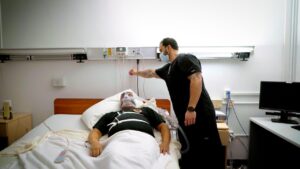Month: August 2025

Alternative Sleep Apnea Treatments for Those Who Can’t Tolerate CPAP
Introduction: When CPAP Isn’t the Right Fit Sleep apnea is a sleep disorder where breathing repeatedly stops and starts during the night. These pauses reduce oxygen levels and can put strain on the heart, brain, and other organs. Left untreated, sleep apnea increases the risk of heart disease, stroke, high blood pressure, type 2 diabetes, and chronic fatigue. See more: Comprehensive Sleep Testing in Perth: Steps to Better Sleep The most common treatment for moderate to severe obstructive sleep apnea (OSA) is Continuous Positive Airway Pressure (CPAP) therapy. This involves wearing a mask connected to a machine that keeps the airway open with gentle air pressure. While CPAP is highly effective, not everyone can tolerate it. Some people find the mask uncomfortable, struggle with the sensation of forced air, or experience skin irritation. The good news? CPAP isn’t the only option. There are several alternative treatments that can help manage sleep apnea effectively for those who can’t or don’t want to use CPAP. Causes of Sleep Apnea Before exploring alternatives, it’s important to understand why sleep apnea happens in the first place. Obstructive Sleep Apnea (OSA) This is the most common form, caused by the throat muscles relaxing too much during sleep. When this happens, the airway narrows or collapses, temporarily blocking airflow. Key risk factors include: Central Sleep Apnea (CSA) In CSA, the brain doesn’t send proper signals to the breathing muscles. It’s often linked to heart or neurological conditions rather than airway blockages. Lifestyle Triggers Certain habits and health conditions can make sleep apnea worse: Example:Sam, 48, developed sleep apnea after gaining 30 pounds over several years. His habit of having a nightcap and sleeping on his back made things worse. Even after trying CPAP, he found the mask too uncomfortable and looked for other solutions. Symptoms: The Obvious and the Overlooked Recognizable Symptoms Subtle or Less Obvious Symptoms These overlooked symptoms can delay diagnosis for years, especially if someone lives alone or doesn’t have anyone to notice nighttime breathing changes. Alternative Treatment Options for Sleep Apnea While CPAP remains the gold standard, there are other effective options for those who can’t tolerate it. The right choice depends on the severity of the apnea, the underlying cause, and personal preference. 1. Oral Appliance Therapy (OAT) Dentist-fitted oral appliances work by repositioning the lower jaw and tongue to keep the airway open during sleep. Advantages: Limitations: 2. Positional Therapy Some people have sleep apnea mainly when sleeping on their back (supine position). Positional therapy uses special pillows, belts, or wearable devices that encourage side sleeping. Advantages: Limitations: 3. Weight Loss and Lifestyle Changes For those who are overweight, losing even 10–15% of body weight can reduce the severity of sleep apnea. Lifestyle changes that help: 4. Myofunctional Therapy This involves targeted exercises for the tongue, throat, and facial muscles. Strengthening these muscles helps keep the airway open during sleep. Example exercises include: Studies have shown these exercises can reduce apnea events, particularly in mild cases. 5. Surgery When structural issues are the cause, surgery may be considered. Options include: Surgery is typically reserved for those who have tried other options without success. 6. Expiratory Positive Airway Pressure (EPAP) Devices EPAP devices are small, disposable valves placed over the nostrils. They create resistance when exhaling, which helps keep the airway open. Advantages: Limitations: 7. Combination Therapy Sometimes the best approach is to combine treatments — for example, using an oral appliance along with positional therapy and weight loss. This can be especially effective for people with multiple contributing factors. Living Well with Sleep Apnea Without CPAP Finding the right alternative to CPAP isn’t just about comfort — it’s about improving sleep quality, restoring energy, and protecting long-term health. Example:After struggling with CPAP for months, Laura switched to a custom oral appliance combined with nasal breathing exercises and side sleeping. Within weeks, her energy returned, her morning headaches vanished, and her partner noticed her snoring was almost gone. Conclusion: Don’t Ignore the Signs Sleep apnea is more than just snoring — it’s a serious health condition that can silently impact your heart, brain, and overall well-being. If CPAP doesn’t work for you, there are other effective treatments available. The key is not to give up. Work closely with a sleep specialist to explore your options, try different solutions, and find the one that fits your needs. The most important step is getting diagnosed and treated. Quality sleep is essential for a healthy life, and addressing sleep apnea can transform the way you feel, function, and live each day.
Read More
At-Home Speech Therapy Options in Castle Hill for Kids and Families
Speech therapy is an essential service that can significantly enhance communication skills in children. For families in Castle Hill, there are various at-home speech therapy options available that cater to the unique needs of each child. This article explores these options, providing insights into effective strategies, resources, and professional support to ensure children receive the best possible care in the comfort of their own homes. Understanding Speech Therapy Speech therapy Castle Hill is a therapeutic approach aimed at improving speech and language skills. It encompasses a range of techniques designed to assist children who may have difficulties with articulation, fluency, voice, or language comprehension. The role of a speech therapist is to assess the child’s specific needs and develop tailored strategies to enhance their communication abilities. In Castle Hill, speech therapy can be delivered in various formats, including in-person sessions, telehealth consultations, and at-home therapy. Each method has its advantages, allowing families to choose the most suitable option based on their circumstances. The Importance of Early Intervention Early intervention is crucial in addressing speech and language delays. Research indicates that children who receive timely support are more likely to develop effective communication skills, which are vital for academic success and social interactions. Parents should be vigilant in recognising early signs of speech difficulties, such as trouble pronouncing words, limited vocabulary, or challenges in understanding language. In Castle Hill, local resources are available to assist families in identifying these issues. Community health services often provide free screenings, allowing parents to gain insights into their child’s speech development and determine whether professional intervention is necessary. At-Home Speech Therapy Techniques Implementing at-home speech therapy techniques can be a practical and effective way to support a child’s communication development. These techniques can be easily integrated into daily routines, making learning both fun and engaging for children. Interactive Play Utilising interactive play is one of the most effective ways to encourage speech development. Engaging children in games that require verbal communication can significantly enhance their language skills. For instance, playing board games that involve turn-taking and conversation can promote social skills and vocabulary usage. Parents can also incorporate storytelling into playtime. Encouraging children to narrate stories or describe their favourite toys can foster creativity and improve their ability to articulate thoughts clearly. This method not only enhances speech but also strengthens the parent-child bond. Reading Together Reading is a powerful tool for language development. Parents in Castle Hill can create a reading routine that includes a variety of books, from picture books to simple chapter books, tailored to their child’s age and interests. Discussing the story, asking questions, and encouraging children to predict what happens next can stimulate their language processing skills. Additionally, parents can use books with repetitive phrases or rhymes to help children practice articulation and improve their phonemic awareness. This technique is particularly beneficial for younger children who are just beginning to develop their speech skills. Using Technology In today’s digital age, technology can play a significant role in speech therapy. There are numerous apps and online resources designed specifically for speech and language development. These tools often include interactive games and exercises that make learning enjoyable for children. Parents can explore options such as speech therapy apps that provide exercises tailored to their child’s specific needs. Many of these apps offer progress tracking features, allowing parents to monitor improvements over time. However, it is essential to ensure that screen time is balanced with other activities to promote holistic development. Professional Support for At-Home Therapy While at-home techniques are beneficial, professional support can provide additional guidance and structure. In Castle Hill, families have access to qualified speech therapists who can offer tailored programmes and strategies to enhance at-home efforts. Finding a Speech Therapist When seeking a speech therapist, it is essential to consider their qualifications, experience, and approach to therapy. Families can start by consulting local health services or educational institutions that may offer speech therapy programmes. Online directories and professional associations can also provide valuable information on registered speech therapists in Castle Hill. It is advisable to schedule an initial consultation to discuss the child’s specific needs and determine the best course of action. During this meeting, parents should feel free to ask questions about the therapist’s methods, expected outcomes, and how therapy can be integrated into at-home practices. Telehealth Options Telehealth has become an increasingly popular option for speech therapy, particularly in light of recent global events. Many speech therapists in Castle Hill offer virtual sessions, allowing families to access professional support from the comfort of their homes. This approach can be particularly beneficial for families with busy schedules or those living in remote areas. During telehealth sessions, therapists can provide live feedback, demonstrate exercises, and guide parents on how to implement strategies at home. This flexibility ensures that children continue to receive the support they need, regardless of external circumstances. Community Resources and Support Groups Castle Hill offers a variety of community resources and support groups for families navigating speech therapy. These resources can provide valuable information, emotional support, and opportunities for social interaction. Local Support Groups Joining a local support group can be an excellent way for parents to connect with others facing similar challenges. These groups often share experiences, strategies, and resources that can be beneficial for both parents and children. Many support groups also host workshops and events featuring guest speakers, including speech therapists and educators. Families can find information about local support groups through community centres, schools, or online platforms dedicated to parenting and child development. Engaging with others in the community can foster a sense of belonging and provide encouragement throughout the therapy journey. Workshops and Educational Resources Various organisations in Castle Hill offer workshops and educational resources focused on speech and language development. These workshops can provide parents with practical skills and knowledge to support their child’s therapy at home. Topics may include effective communication strategies, understanding speech disorders, and how to create a language-rich environment. Additionally, many libraries and community centres
Read More
How Speech Therapy for Autism Can Support Your Child’s Development
Speech therapy is an invaluable resource for children with autism spectrum disorder (ASD). It provides tailored support that can significantly enhance communication skills, social interactions, and overall development. Understanding how speech therapy can benefit your child is crucial for parents and caregivers seeking to foster their child’s growth and integration into society. Understanding Autism Spectrum Disorder Autism spectrum disorder is a complex neurodevelopmental condition that affects how individuals communicate, interact, and perceive the world around them. The symptoms and severity of autism can vary widely, leading to a spectrum of challenges. Early intervention through speech therapy for Autism is key, as it can greatly influence the trajectory of a child’s development. Many children with autism experience difficulties in verbal and non-verbal communication. They may struggle with understanding language, expressing their thoughts, or engaging in social interactions. These challenges can lead to frustration and isolation, making it essential to explore effective support options such as speech therapy. The Role of Speech Therapy in Supporting Development Speech therapy is designed to improve communication skills through various techniques and strategies. For children with autism, speech therapists work on both verbal and non-verbal communication, helping them to express their needs, understand others, and engage more effectively in social situations. Therapists often use play-based activities and structured exercises to make learning enjoyable and relevant. This approach not only enhances communication skills but also builds confidence and social skills, which are crucial for a child’s overall development. Enhancing Verbal Communication Skills One of the primary focuses of speech therapy for children with autism is enhancing verbal communication skills. This includes working on articulation, vocabulary, and sentence structure. Therapists employ various methods, such as modelling language, using visual aids, and engaging in interactive activities to encourage children to express themselves more clearly. For instance, therapists may use picture exchange communication systems (PECS) to help non-verbal children communicate their needs. This method allows children to use pictures to convey messages, gradually leading to the development of verbal skills as they become more comfortable with communication. Improving Non-Verbal Communication Non-verbal communication is equally important in speech therapy. Children with autism may struggle with understanding body language, facial expressions, and tone of voice. Speech therapists help children recognise and interpret these non-verbal cues, which are essential for effective communication and social interaction. Through role-playing and social stories, therapists can create scenarios that allow children to practice their non-verbal communication skills in a safe environment. This practice helps children become more aware of how their actions and expressions affect others, fostering better social connections. Building Social Skills Social skills are often a significant area of difficulty for children with autism. Speech therapy can play a vital role in developing these skills by teaching children how to initiate conversations, take turns, and respond appropriately in social situations. Therapists may use group therapy settings to provide opportunities for children to interact with peers, allowing them to practice their skills in real-time. Additionally, therapists can work with parents and caregivers to reinforce social skills at home. This collaboration ensures that children receive consistent support and encouragement, helping them to generalise their skills across different environments. Individualised Therapy Plans Every child with autism is unique, and their speech therapy plans should reflect their individual needs and strengths. Speech therapists conduct thorough assessments to identify specific areas of difficulty and develop personalised therapy plans that target these areas effectively. These plans may include specific goals, such as improving vocabulary, enhancing conversational skills, or fostering social interactions. Regular progress monitoring allows therapists to adjust the plans as needed, ensuring that the therapy remains relevant and effective. Collaboration with Other Professionals Effective speech therapy often involves collaboration with other professionals, such as occupational therapists, psychologists, and educators. This multidisciplinary approach ensures that all aspects of a child’s development are addressed, providing a comprehensive support system. For example, occupational therapists may focus on sensory integration, while speech therapists concentrate on communication skills. By working together, these professionals can create a cohesive strategy that supports the child’s overall development and well-being. Involving Parents and Caregivers Parents and caregivers play a crucial role in their child’s speech therapy journey. Therapists often involve them in sessions, providing guidance on how to reinforce skills at home. This involvement not only empowers parents but also helps create a consistent learning environment for the child. Parents can also learn strategies to enhance communication during daily routines, such as using descriptive language during playtime or encouraging their child to express their feelings. This active participation fosters a supportive atmosphere that promotes growth and development. Benefits of Early Intervention Research has shown that early intervention can significantly improve outcomes for children with autism. The earlier a child begins speech therapy, the more likely they are to develop effective communication skills and social abilities. Early intervention can lead to increased independence and improved quality of life as children grow. By addressing communication challenges early on, parents can help their children build a strong foundation for future learning and social interactions. This proactive approach can also reduce the likelihood of behavioural issues stemming from frustration and communication difficulties. Long-Term Outcomes The long-term benefits of speech therapy for children with autism are profound. Many children who receive early and consistent speech therapy experience significant improvements in their communication skills, leading to better social interactions and academic success. These skills can open doors to new opportunities and enhance their overall quality of life. As children grow, the skills they acquire through speech therapy can help them navigate various social settings, build friendships, and pursue their interests. This empowerment is essential for fostering independence and self-confidence in children with autism. Conclusion Speech therapy is a vital component of support for children with autism. By enhancing communication skills, improving social interactions, and fostering independence, speech therapy can significantly impact a child’s development. Early intervention, individualised therapy plans, and collaboration with parents and other professionals are key factors in maximising the benefits of speech therapy. As a parent or caregiver, understanding the importance
Read More